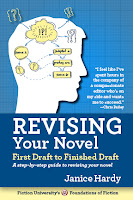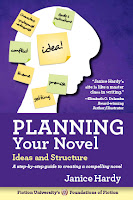There are things I know I need to do as I write that I don't always do in a first draft. Plot things, like a subplot that needs to be there, or a bit of information that has to be revealed for later events to work. This happens to me all the time, and I've gotten to the point where I just don't fret over it anymore when it happens. I know I'll fix it in revisions.
But I'll be honest here--sometimes it's a pain to find the right spot to add something and not mess up what you already have. But it can also lead to something seriously cool happening. An interesting part of Blue Fire occurred this way. There was a planned plot point I needed to slip in, and for the life of me, I just couldn't figure out how or where to do it. Finally I thought, "hmmm, what if this didn't happen?" and that opened the series to a much more interesting situation than I had originally planned.
Let's look at those leftover plot pieces, subplots, back story, or anything else that needs to go where it might not wanna go, and figure out how to make them read like you planned it all along.
Get a Lay of the Land
The first thing I do is look at what I need to insert, then check my outline or synopsis to see where it might work. It's also a good way to see logistically where it should go. It needs to happen before chapter six, but after chapter three kinda deal. If you don't outline, you can take notes or just jot down ideas in the text (or however you normally handle revision ideas and plans).
Giving a Little Help
Once I get a sense of the overall book, I look to see if there are any weak spots that might be fixed by this addition. Spots where the pacing drops or the stakes aren't high enough. Places where there's too little (or too much) action. Maybe this bit can add more conflict. Think outside the box here. You might have a plot point that can work with a little tweaking to that point, so don't be afraid to consider changing your original plan.
Reconnaissance
I'll read the chapters or scenes I think might work, keeping an eye out for any lines or situations where I can edit to lead into this new addition. Things I look for:
Mood: What's the emotional level behind the bit you want to add? If it's something that will make your character sad, another sad spot might be the perfect lead in.
Theme: Is there anything that thematically works with the new bit? If you're trying to insert something that shows the futility of war, is there a spot where people are doing something futile? Maybe you can use that as a trigger or a lead in. And speaking of triggers...
Triggers: Although our minds work in weird ways and thoughts pop in there for the weirdest of reasons, in books, there's usually a stimulus that triggers a thought or action so things don't feel stuck in or out of the blue. Is there anything that would cause your character to think about something that would naturally lead to the bit you need to add?
Going In
After I've found my spot, I start adding the plot bits. Sometimes this is a full scene, other times it's a line here or there. You have to be careful with this, because it's easy to stall the story with the new stuff if it doesn't flow smoothly. There's a good chance you'll change the pacing with the addition, so do a few read throughs to make sure the chapter or scene is still working as intended.
Clean Up
If you're anything like me, when you add stuff after the fact, you have a tendency to add too much. I always have to go back and read the entire sections I've changed as one big piece to see how it flows and to make sure I haven't said basically the same thing two or three times while finding the right spot for it. I also check to make sure I didn't de-rail something else, or shift focus too much so the character is in the wrong emotional state for what's really going on. Worrying about a minor detail when the world is coming to an end for example.
While this is specifically about plot points, this plan works for any information you want to add in. Need to flesh out a character arc? Add in foreshadowing? Do more world building? Just approach it the same way to help keep you organized.
How do you handle leftover or forgotten plot points? Do you revise in layers or tweak as you go? How do you handle a first draft?
 Looking for tips on revising your novel? Check out my book Revising Your Novel: First Draft to Finished Draft,
a series of self-guided workshops that help you revise your manuscript
into a finished novel. Still working on your idea? Then try my
just-released Planning Your Novel Workbook.
Looking for tips on revising your novel? Check out my book Revising Your Novel: First Draft to Finished Draft,
a series of self-guided workshops that help you revise your manuscript
into a finished novel. Still working on your idea? Then try my
just-released Planning Your Novel Workbook.  A
long-time fantasy reader, Janice Hardy always wondered about the
darker side of healing. For her fantasy trilogy The Healing Wars, she
tapped into her own dark side to create a world where healing was
dangerous, and those with the best intentions often made the worst
choices. Her novels include The Shifter, Blue Fire, and Darkfall from Balzer+Bray/Harper Collins. The Shifter,
was chosen for the 2014 list of "Ten Books All Young Georgians Should
Read" from the Georgia Center for the Book. It was also shortlisted for
the Waterstones Children's Book Prize, and The Truman Award in 2011.
A
long-time fantasy reader, Janice Hardy always wondered about the
darker side of healing. For her fantasy trilogy The Healing Wars, she
tapped into her own dark side to create a world where healing was
dangerous, and those with the best intentions often made the worst
choices. Her novels include The Shifter, Blue Fire, and Darkfall from Balzer+Bray/Harper Collins. The Shifter,
was chosen for the 2014 list of "Ten Books All Young Georgians Should
Read" from the Georgia Center for the Book. It was also shortlisted for
the Waterstones Children's Book Prize, and The Truman Award in 2011.  Janice is also the founder of Fiction
University, a site dedicated to helping writers improve their craft.
Her popular Foundations of Fiction series includes Planning Your Novel: Ideas and Structure, a self-guided workshop for planning or revising a novel, the companion Planning Your Novel Workbook, Revising Your Novel: First Draft to Finished Draft, and the upcoming Understanding Show Don't Tell (And Really Getting It).
Janice is also the founder of Fiction
University, a site dedicated to helping writers improve their craft.
Her popular Foundations of Fiction series includes Planning Your Novel: Ideas and Structure, a self-guided workshop for planning or revising a novel, the companion Planning Your Novel Workbook, Revising Your Novel: First Draft to Finished Draft, and the upcoming Understanding Show Don't Tell (And Really Getting It). Website | Facebook | Twitter | Goodreads | Amazon | Barnes & Noble | iTunes | Indie Bound


You nailed it! Great advice.
ReplyDeleteYou should really. Really. Really. Teach a class. I feel like I'm stealing learning here (although I am a professional thief, so it's only natural that I do).
ReplyDeleteThis is super helpful. :)
ReplyDeleteHow do you hold it all in your head? I'm only on my first draft--and not even finished that--and already my brain overloads on the when-did-I's and where-did-I's...
I've been color-coding POVs, so that at least helps me find things more quickly. Do you have certain techniques? Do you use the writing software that I hear helps organize somehow?
:) I meant to just say thanks and it turned into questions... I do appreciate the insight you share here!!
Your blog is excellent! Thanks for all the good advice.
ReplyDeleteI was thinking about this just the other day. Having to add something is almost as disruptive as cutting something out! Some nice ideas here.
ReplyDeleteI really enjoyed this article. I used to doubt myself while working on a 1st draft. I had this crazy idea it had to be right the first time. Really helpful and comforting to see how authors go back to craft their stories. Thanks so much!
ReplyDeleteDitto to all the above comments! :D
ReplyDeleteThanks all. JEM, I used to teach an online class a few years back, actually. Loved it, bit it took a lot of time. Blogging is a nice happy medium.
ReplyDeleteAaaaand I'm marking this for future reference. In drafting my current WIP, there are so many places where I'm like, "Doh, just thought of something I need to mention in the previous chapter. Uh, I'll fix that later." And the thought of all those laters was freaking me out. Hopefully your advice will make the task more manageable. Thanks!
ReplyDeleteI love hearing your process, Janice. You're a hero for sharing with us!
ReplyDeleteEnjoyed reading this and the comments. Kristan commented "I'll fix that later" and sputnitsa talked about "overloads on the when-did-I's and where-did-I's" - I do a story ladder that helps me with that stuff - sort of like an outline in progress, that of course, keeps getting changed and added to as I write. A good place to put notes, too.
ReplyDeleteThis helps me! I did something similar but was feeling my way-- I put all my scenes on note cards so that I could get the lay of the land and that helped me digest it easier and see where something would fit. I then broke everything into scenes in notebooks and revised by scene. It was easier to get through if I looked at it in smaller chunks...
ReplyDeleteJust saved this in evernote for when I finally finish drafting. Great advice.
ReplyDeleteAngelaquarles, note cards are great. I used them for a long time, especially when I had multiple POVs.
ReplyDeleteTasha, thanks! Glad it helped.